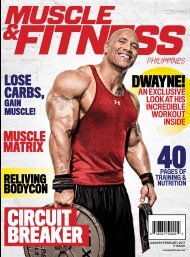SHAPE_OCTOBER_2016
Create successful ePaper yourself
Turn your PDF publications into a flip-book with our unique Google optimized e-Paper software.
the belly shrink<br />
growth hormone, which releases<br />
fat from its stores in the body so it<br />
can be delivered to your muscles<br />
for energy, Dr. Isaacs says. Still,<br />
even with all this in your favor,<br />
four years of keg parties and latenight<br />
pizza may have left you with<br />
a post grad gut, and those poor<br />
eating and drinking habits have<br />
a tendency to linger just about as<br />
long as your student loan payments.<br />
“After graduation, people<br />
tend to spend more time sitting at<br />
a desk, and this sedentary lifestyle<br />
can lead to more weight gain,<br />
especially if you’re still drinking a lot<br />
and not keeping close tabs on your<br />
diet,” Dr. Isaacs explains.<br />
This is particularly true if you<br />
consume a lot of carbs. A recent<br />
study in the Journal of Nutrition<br />
revealed that large amounts of<br />
processed carbs (the highercarb<br />
participants in the study<br />
were eating 55 percent carbs,<br />
18 percent protein, and 27<br />
percent fat) raise the body’s<br />
level of insulin, which prevents<br />
fat from being unlocked from<br />
abdominal fat stores and<br />
burned off. Another factor:<br />
“Many twentysomethings<br />
haven’t hit their fitness stride<br />
yet; they’re doing too much<br />
steady-state cardio and not<br />
enough strength training<br />
and cranking out old-school<br />
crunches, a particularly ineffective<br />
combination for chipping<br />
away at belly fat,” says<br />
Holly Perkins, a strength-andconditioning<br />
specialist and<br />
the author of Lift to Get Lean.<br />
Flat-ab fix Start by shifting<br />
your eating habits away<br />
from college carbo-loading.<br />
“Help keep insulin at a healthy<br />
level by following a moderatecarb<br />
diet, in which most of your<br />
carbs come from nutritious<br />
unprocessed sources like whole<br />
grains, beans, fruits, and vegetables,”<br />
says nutritionist<br />
Lisa Young, Ph.D., the author<br />
of The Portion Teller. The participants<br />
in the Journal of Nutrition<br />
Trade<br />
some<br />
steady<br />
cardio for<br />
a few HIIT<br />
sessions<br />
to burn<br />
ab fat,<br />
plus lift<br />
and plank<br />
to keep<br />
it tight.<br />
study who were given a moderately<br />
low-carb diet (43 percent<br />
carbs, 18 percent protein, and<br />
39 percent fat) lost 11 percent of<br />
their abdominal fat after eight<br />
weeks, compared with those on a<br />
low-fat, higher-carb diet, who<br />
lost only 1 percent ab fat.<br />
And because the goal is to<br />
burn flab, you need to choose<br />
calorie-incinerating workouts.<br />
“It’s important to incorporate<br />
steady-state cardio, interval training,<br />
and strength training,” Perkins<br />
says. She recommends doing two<br />
35- to 40-minute steady-state<br />
cardio sessions a week at a pace<br />
that’s about a 7 out of 10 on the<br />
intensity scale; two 30-minute<br />
interval workouts (go for two<br />
minutes at moderate intensity<br />
followed by two minutes at an<br />
almost-all-out pace) to maximize<br />
growth-hormone secretion<br />
WHEN YOU’RE IN YOUR . . .<br />
For many women, their thirties are the time<br />
to have babies. Pregnancy can cause your<br />
rectus abdominis muscles (your frontand-center<br />
six-pack muscles) to stretch to<br />
the point of separation, a painless condition<br />
called diastasis recti, which Brazilian<br />
researchers found affected 68 percent of<br />
women above the belly button and 32 percent<br />
below, when measured at up to eight<br />
weeks postpartum. “The muscles<br />
usually move back together on their own,”<br />
says Mary Jane Minkin, M.D., a clinical<br />
professor of obstetrics, gynecology, and<br />
reproductive sciences at the Yale School of<br />
Medicine.<br />
“In extreme cases, surgery may<br />
be needed to repair the separation.”<br />
Otherwise, you’re probably just dealing<br />
with some leftover fat and ab muscles that<br />
became stretched out during pregnancy.<br />
That doesn’t mean they can’t snap right<br />
back, but it takes some effort. Luckily, you<br />
still have a respectable metabolism in your<br />
thirties. While it drops another 1 to 2 percent<br />
from the first small dip in your twenties<br />
during this decade, that’s not really going<br />
to catch up to you for another decade or<br />
30s<br />
so. Estrogen levels can start to drop for<br />
and fat burning; and two days<br />
of strength training to build lean<br />
muscle mass, which ups your<br />
calorie burn. Any type of strength<br />
training will be effective, as long<br />
as the program gets progressively<br />
harder (more weight, more reps)<br />
so that you continue to challenge<br />
your body. If you’re not up for<br />
sweating six days a week, you can<br />
double up and do the strength<br />
training on your cardio or interval<br />
days. “Twentysomethings still<br />
have metabolism and hormones<br />
on their side, so they just need<br />
to develop a definitive fitness<br />
strategy that includes a balance<br />
of cardio and strength training<br />
to kick-start their burn and firm,”<br />
Perkins says.<br />
some women in the late thirties as fertility<br />
diminishes, but less estrogen isn’t an issue<br />
until you are well into your forties. And you<br />
can still cash in on your growth hormone<br />
production for now too.<br />
Flat-ab fix Getting your prebaby belly<br />
back requires a two-pronged approach:<br />
You need to melt the flab that’s covering<br />
your abs and strengthen your stretchedout<br />
muscles. Trainer Sara Haley, the creator<br />
of the Expecting More pre- and postnatal<br />
exercise DVD programs, suggests the following<br />
time-saving high-intensity routine,<br />
which has you moving fast enough to keep<br />
your heart rate up to torch calories and<br />
incorporates moves designed to tone and<br />
tighten your whole core; these exercises<br />
are safe for those with diastasis recti, as<br />
long as it’s not severe. After warming up, do<br />
each of the following moves for one minute:<br />
high knees (run in place), plank squats<br />
(start in a plank, then jump feet forward<br />
and pop up into a squat), knee repeaters<br />
(get into a low lunge, clasp hands over your<br />
head, and bring your back knee up to your<br />
chest while simultaneously bringing your<br />
hands down to meet the knee; do one<br />
minute per leg), and dead bugs (lie faceup<br />
on the floor with your legs raised, knees<br />
24 <strong>OCTOBER</strong> <strong>2016</strong> <strong>SHAPE</strong>.COM















